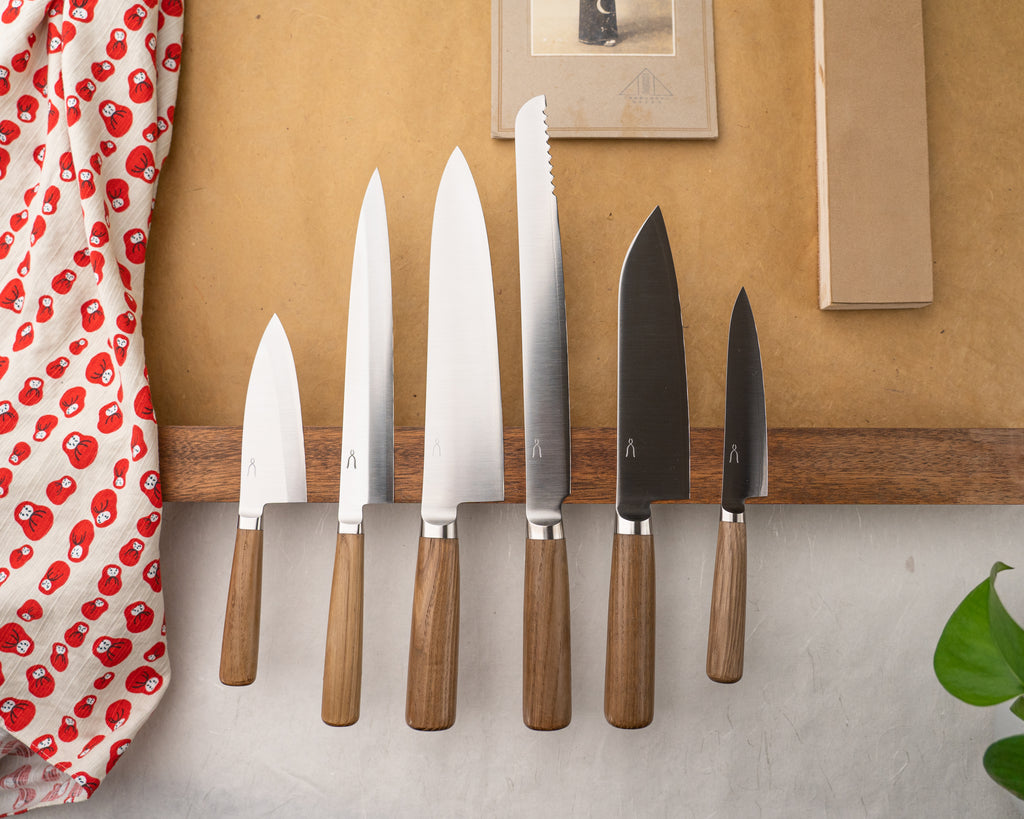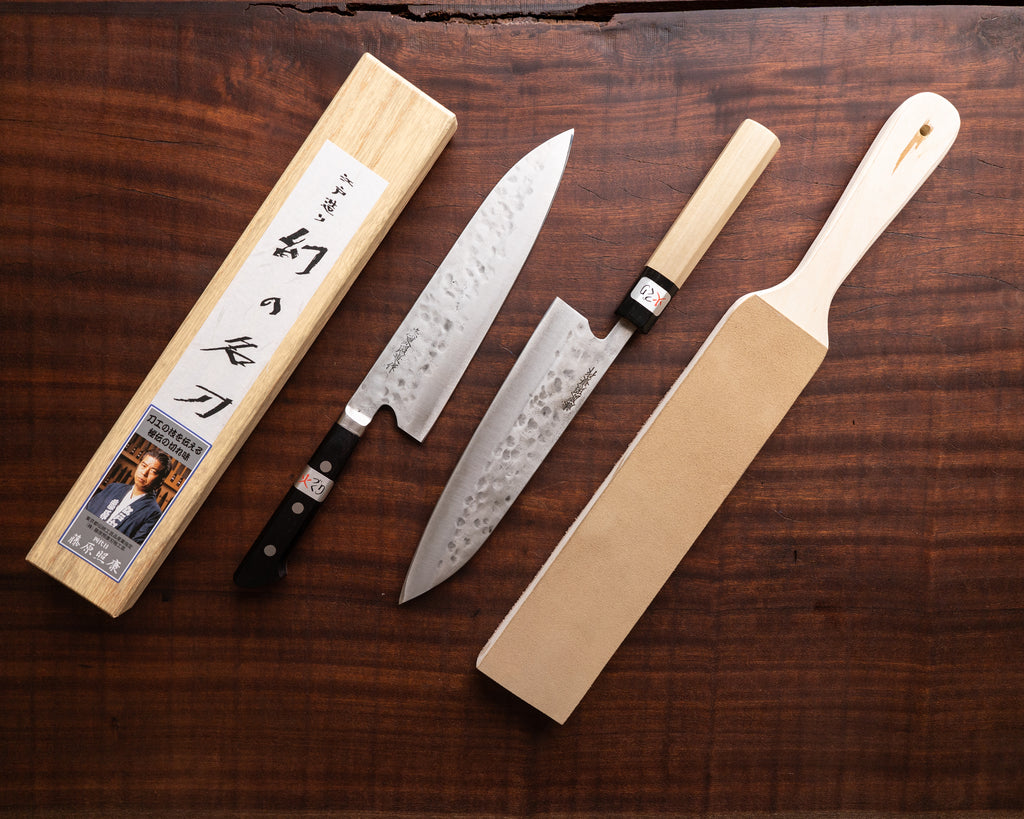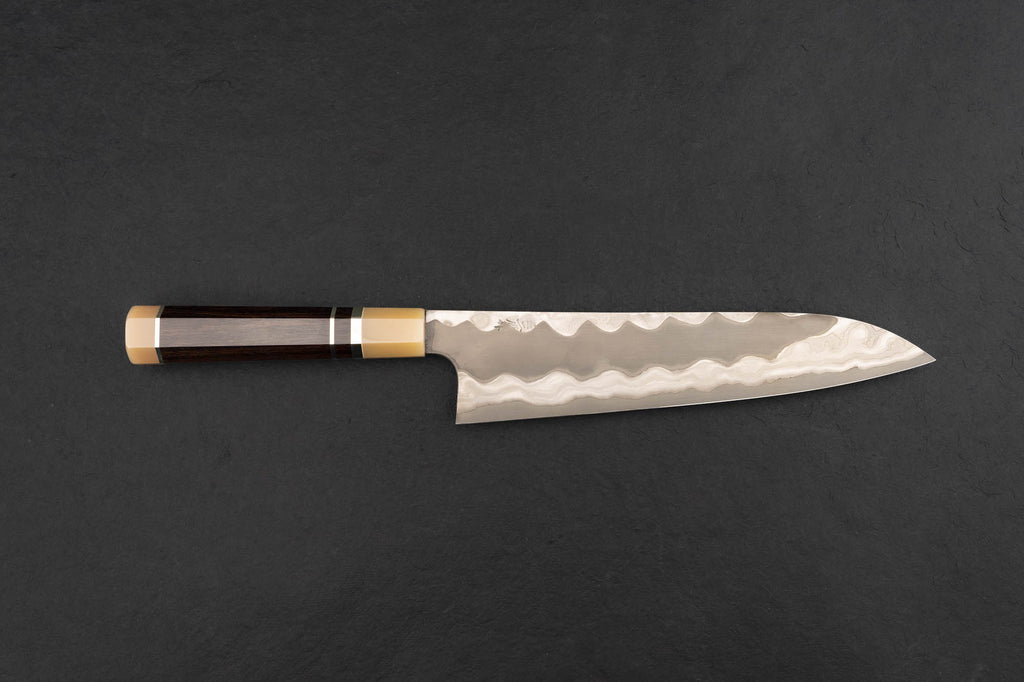
$100 knife v.s. $1000 knife: What's the Difference?
One of the questions we get most often in the store is, “which is the most expensive knife around?” There’s something to be said about holding a knife worth more than a mortgage payment. A certain feeling comes over you, and all of the world’s problems disappear. A follow-up question often follows: “why is a knife so expensive?”
You may be surprised to hear this, but you can get yourself a great Japanese knife for around $100. We even have some that will only cost you less than that! They may not be from a master blacksmith, but this doesn’t mean they’re not good knives.
Seriously though, we have a vast price range available, and it can be challenging to understand, let alone explain, why a knife costs $100, $250 or an arm and a leg. I work with these knives all day, so I’ll break this all down in ascending order and a few categories to help you understand it in simple terms! You’ll notice as we work our way down this list that the following factors have a big part to play in the cost of a knife (or any product, really):
- Materials used
- Techniques, skill, and human v.s. machine labor
- Production size
- Fit and finish
Entry Level Japanese Kitchen Knives ($50-175)
Our first bracket will cover knives in the $50-175 price range. Let’s think of this category as the Pontiac Sunfire of the group. It may not have all the bells and whistles that some others have, but it’ll get you from point A to point B, which is often all you need for a first knife!
Generally, the knives you’ll find at this price point are going to be machine-forged, often called “factory-made”. Factory-made in Japan isn’t quite the same as in most other places. These knives are not industrialized and assembled by robot arms but instead use modern-day machinery to help with production. Usually, these knives will be stamped, rolled, or forged by machine but then finished, handled, sharpened, and carefully inspected by expert craftspeople.
Knives with more basic performance and lower steel hardness will appear in this category. They can also be on opposing ends of the maintenance spectrum. They’ll either use more common stainless steel such as VG10 or AUS10 or are what we call “full carbon”, meaning that the entire blade is made of high-carbon steel. The full-carbon knives often aren’t as costly since carbon steel is less expensive and more workable than most stainless steel; the significant trade off is that they need to be kept dry to prevent rusting.
If they have a Wa (Japanese) handle, odds are it will be made of magnolia or chestnut wood, and the ones boasting a Western(riveted) handle will more often than not be made of pakka wood, a wood and resin composite. These materials are more accessible and help keep the price down. You’ll find a lot of simpler finishes, such as migaki (polished) or tsuchime (hammered) finishes, and the knives will be comfortable, but I wouldn’t expect the spine and heel of the blade to be super polished or rounded off at this stage. A couple of good examples would be the Haruyuki Mugi line and the Fujimoto Kurouchi Forged line, both great lines with a very approachable price point.
There are tons of great knives to be found here, and they are still mind-blowingly sharp. If taken care of properly, there is no reason why any of these cannot become a family heirloom. Now, if you’re looking for an eye-catching, jaw-dropping, make-your-coworker-jealous type of blade, you’ll want to step into the next category.

Even factory-forged knives like the Tadafusa Hocho Kobo are ridiculously hands-on.
Mid-range knives for your kitchen ($175-400)
The second bracket is where things get exciting and a touch more diverse. In this range, you’ll find some knives that are entirely hand-made by one single blacksmith, as well as some machine-forged blades made of high-performance steel with much fancier finishing touches.
I would compare this group to the Honda civics, or Ford focuses of the world. Just like every major car manufacturer makes a vehicle in this range, almost most knife makers have a line in this bracket, and the list of options you’ll have to choose from will be endless but may also limit those looking for a tailor-made knife. You’ll get to pick from many different finishes and materials. Still, if you have something extremely specific in mind, a hand-forged White Carbon #1 240mm kiritsuke with a hammered kurouchi and a western handle finish, for example, you may need to step up to the next category to find your dream knife.
This is also where we’ll start to see more of the stainless-clad carbon steel core blades, meaning that a layer of carbon steel is sandwiched between two layers of stainless steel to make the knife. This helps reduce the maintenance associated with carbon steel, as only about 2mm of it will be left exposed at the edge. Only the edge of your knife is likely to rust, and most of it is low-maintenance. We also start seeing more fancy finishes, such as suminagashi (Damascus) or mirror-like migaki polishes. We also get more super-hard steels, like the super blue carbons or R2 powdered stainless steel.
Most of the knives we carry land in this $175-$400 range, meaning you’ll have nearly endless choices on your knife-buying journey. A couple of my favourite lines are the Nigara Tsuchime and the Takamura Akagouhan. Both are handmade, super high performing and look badass! The fit and finish are superb, and the performance will easily match. Some other options I like to show folks are the Haruyuki Zanpa or the Miyabi Birchwood line. These are some of the prettier knives we carry and, in the Miyabi Birchwood lines’ case, also some of the highest-performing steel we can get our hands on. While these may not be hand-forged, there are still lots of hands involved in the process of making these knives. They start from a machine-forged piece of steel and are then ground, shaped, fit, and finished all by hand. This allows them to craft some genuinely magnificent blades but keep the price approachable to most folks.

The incomparable Miyabi Birchwood- check out that finish!
Third gear ($400-700+)
We’ve finally made it to the third category! Knives here will likely tick every box for knife collectors and those who simply want the best. They range from $400-700 (and above), and to stick with our car analogy, they are more akin to Porsches or Cadillacs. You get looks, comfort, AND insane performance!
These are the knives made solely by master craftspeople who either work alone or have a small group of apprentices to help them pass down their craft and keep up with demand. These are also knives made using only the best of materials and often more labor-intensive techniques, such as forge-welding their steel in-house to create multi-layered blades (instead of buying it pre-laminated from the factory) or hand-hammering the primary bevel instead of only using a grinding stone to form it. Many of these blades are made of similar materials as the second category but handled with more skill and attention to detail, allowing them to attain their highest potential. The fit and finish are often par to none, and the performance will blow your mind!
A couple of my favorite examples are Fujiwara san’s Maboroshi line or Hado Sakai’s Junpaku line. Both are very different but made with the same amount of care and attention to detail. While the knives of fourth-generation swordsmith Teruyasu Fujiwara feature a more rustic finish, he spends far more time hammering his steel. He heat-treats them harder than other blacksmiths, leading to some of the best performing blades we’ve ever seen. Hado Sakai, by comparison, comprises a team of highly skilled knife sharpeners who take raw forged blades from local makers and transform them with something akin to knife alchemy. They thin, shape, and bevel them in such a way that makes them mind-blowingly sharp and a must-have for any collector.

Fujiwara's Maboroshi line is a classic, and comes in both handle styles!
We could make a case for a fourth bracket, but from here, the price goes through the roof and doesn’t tell you precisely what you’re getting. These are highly collectible blades made by some of the most renowned masters in Japan. While most of the collectible knives you’ll find will easily cost you in the thousands, you’ll also find some from every bracket here. Similar to how you’ll find proud VW Westfalia owners meet up to show off their unique, characterful vans next to a group of shiny, barely-touched Lotuses or Ferraris. This category will have knives with customized psychedelic handles next to a damascus blade resulting from Kageura-san’s sixth-time coming out of retirement. These are the types of knives we’ll often feature in our bi-annual “Garage sale” in May and November, when we bring in all sorts of oddities, collectible knives, blades from new exciting makers, and occasionally knives from a maker on the verge of retirement.

Truly bonkers Damascus: collector's edition Gyuto 240mm by Nigara Hamono. It's called the Troll Killer. Seriously.
Shopping for a new knife can be overwhelming, but it should also be fun! There is a lot of information to process, especially if you don’t know much about knives, and that’s why we’re here to help you decipher it. Most of it comes down to personal preference. There is no right or wrong when you go with Japanese knives, but I’ve always found that knowing and understanding what I’m putting my money towards nearly guarantees I'll be happy with any of my purchases! If you need more help understanding, check out our YouTube channel, have a live chat with us here, or visit our shops in Calgary, Edmonton, Ottawa, and Vancouver!





